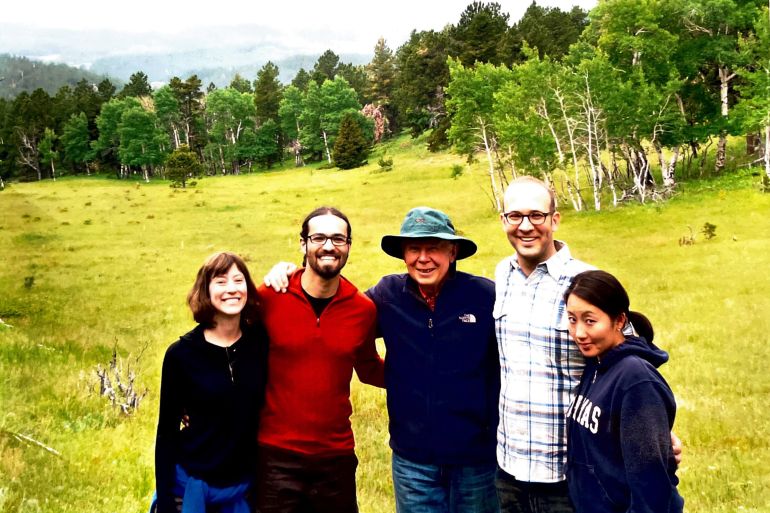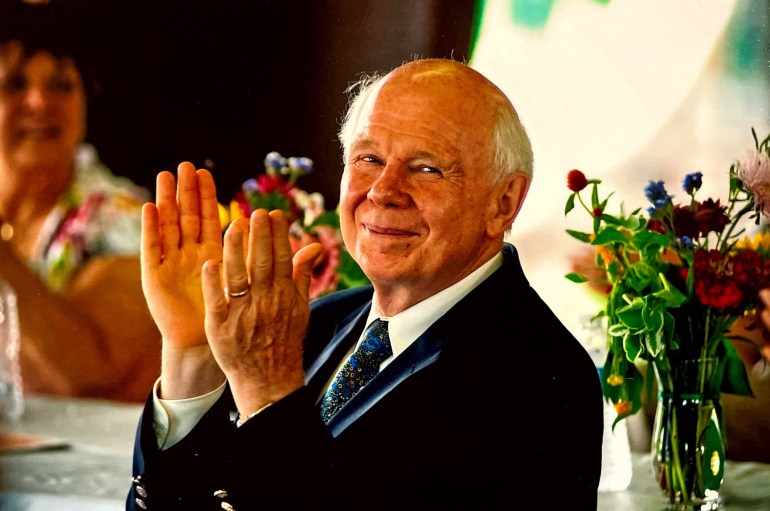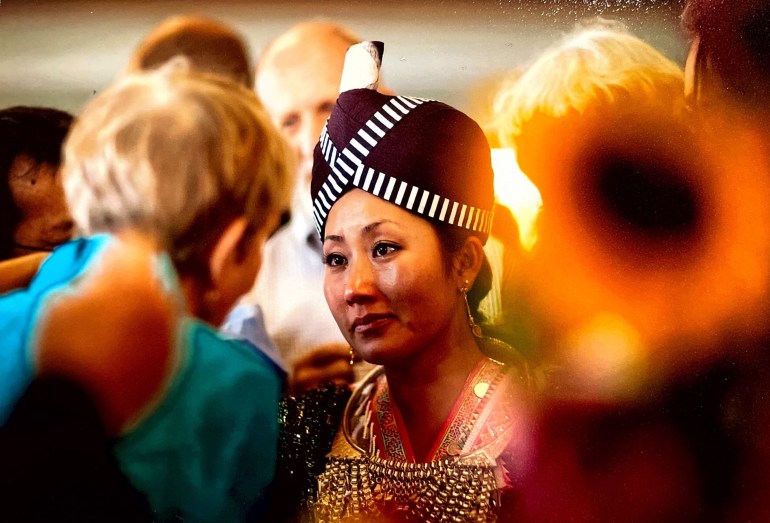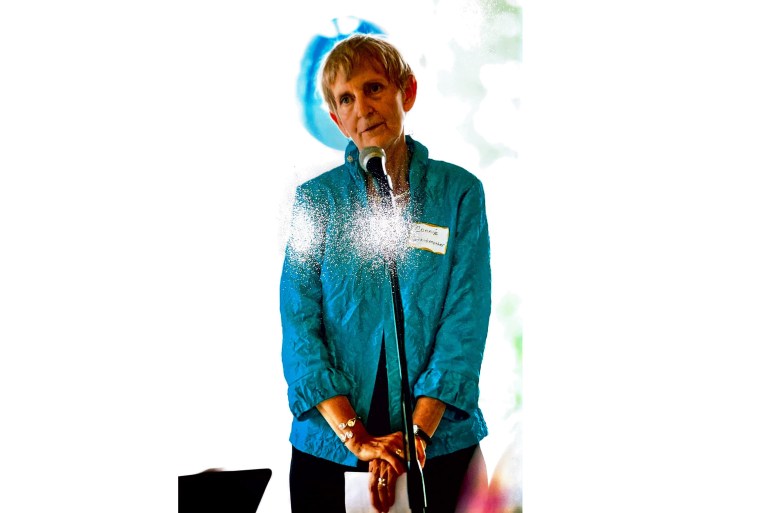An unexpected friendship: A lighthouse across the years
Writer Kao Kalia Yang reflects on her friendship with an older couple who has guided her life – and her career.

The first time I saw Stan Heginbotham, we were standing in an elevator. It was January 2003 and I had just turned 22 years old.
My stomach was quivering and my hands were clasped tight around the unhemmed sleeves of my first-ever suit jacket. Around me, there were others, young men and women in suits that fit them. Stan stood by the panel of buttons, an older gentleman with white hair and shiny shoes.
Keep reading
list of 4 itemsUK returns looted Ghana artefacts on loan after 150 years
Fire engulfs iconic stock exchange building in Denmark’s Copenhagen
Inside the pressures facing Quebec’s billion-dollar maple syrup industry
I was in Los Angeles, on my way to the first of two interviews as a finalist for one of the country’s biggest graduate fellowships to support students whose families are new to America. I was graduating from college soon and wanted to become a writer but was unsure of how I might pay for a graduate education in writing.
Years earlier, I’d seen a flyer for the fellowship and tucked it into a book, thinking that I was, if anything, a new American. I had come to the US at the age of six from the refugee camps of Thailand; my family were survivors of America’s secret war in Laos.
In that elevator, I was trying hard to anticipate the interview questions, while worrying about the hems of my suit pants and sleeves coming undone because they were too long and I had folded them in.
The elevator dinged. People flowed in and out. The elevator dinged again. It was my floor. On my way out of the elevator, I stole a quick look at the faces of the other finalists. My eyes rested on Stan’s face. He winked at me and smiled. I noticed his kind eyes and how they glistened. I couldn’t muster a smile in return as the doors closed.
Doing my best
Five minutes later, I sat across from a panel of well-dressed professionals in the hotel conference room. I answered their questions about my background as a Hmong refugee, my journey through high school and college, and my dreams of becoming a writer. I hadn’t done anything truly remarkable. I had only done my best at every point in time.
It took everything I had to sit there and answer their questions. My soft voice trembled despite my effort to remain steady. I realised that while my hands were still, my feet swung beneath me, too short to touch the floor even in heels.
Later that afternoon, I was surprised to see the man from the elevator sitting across from me in the panel for the second interview. His eyes sparkled as his hands made fast notes on his pad.
I remember the final question of the interview from a younger man in a black suit, “Why did you get certified in first aid and CPR?”
I remember my honest answer: “I had to take care of my younger siblings when Mom and Dad were at work. I wanted to be as prepared as I could be in the event of an emergency.”
As I walked out of that interview, I thought of the incredible young finalists for the fellowship, many from Harvard and Stanford already studying medicine and law, a few studying both. People had started companies, some were running their own nonprofits, and there I was about to finish college but unable to speak in English beyond a whisper and only when it was essential. I had been a good student but never vocal, and many times, others have read my quietness as an inability to think deeply or well.

Becoming family
I didn’t know then that I would get the fellowship; that Stan, a consultant with the fellowship, and the other panellists, would advance my dream of becoming a writer.
I didn’t know that beyond the fellowship, this white man with glittering eyes and his wife, Connie, would become critical guides for me as I adventured toward the life of a writer; that, even more importantly, they would become family, honorary grandparents, to me, in a world where none of mine remained because of war and poverty, displacement and disease.
Growing up in refugee enclaves, I didn’t have close white friends, let alone one who was more than 40 years older than me. Stan also had an educational and economic background that was foreign to the life my family and I shared.
I was born in a refugee camp, the remnants of a war most of the world didn’t know about. I went to a public school, grew up in low-income housing and in a household that practised shamanism and believed in the power of our ancestors. Before coming to America, we knew little about higher education.
Stan was born to a white family and raised in a Christian home. He had gone to prestigious universities for his undergraduate and graduate degrees and was as educated as a person could be.
How could two individuals from such different backgrounds become friends? What might that friendship look like? I had no idea.
The seeds of friendship had been planted in that elevator, but the friendship bloomed after I was awarded the fellowship. Stan and I began emailing back and forth about graduate school options. I decided on a university in New York City, where Stan and Connie, who spend most of their year in Colorado, live in the winter. They knew and loved the city and offered to share it with me.

Building lives
As a 22-year-old graduate student in New York City, away from my family in Minnesota for the first time, I was unsure of how to navigate the maze of bodies and buildings. It was Stan and Connie who showed me the beauty of Manhattan and took me out to eat at the Oyster Bar in Grand Central Station.
Along Broadway Avenue, on the way to meet Connie for dinner, I asked Stan: “So did you like Connie when you first met her?” When I looked beside me, he was nowhere in sight. He was standing behind me, mouth wide open, hands opened at his side, eyes on the sky above. He called out to me: “I didn’t like her. I loved her.”
Years later, when I was falling in love and uncertain whether I could build a life with someone based on feelings alone, I visited Stan and Connie in their Colorado home with him. At their candle-lit table, a small vase of wildflowers at its centre, the open window letting in the shadows of a faraway mountain, they asked him good questions, listened intently, and then later welcomed him into their lives with open arms and hearts.
Stan and Connie spoke at our wedding a year later at a park by a lake in Minnesota, where my soon-to-be husband and I made our vows to each other as we stood in a circle of family and friends.
When we had our children, they came to Minnesota – first for our daughter and then for our twin sons. Each time, they held the babies close, looked into their small faces, and welcomed them with love.
We visited them in Colorado and sat on their patio overlooking the distant peaks with blankets over our laps, savouring the hot orange of the sun descending as our little girl raised herself up in their living room, hands in the air, walking for the first time.

Time untangled
The last time I saw Stan Heginbotham, he and Connie were visiting my family and me at a rental house in the town of Estes Park in Colorado in June 2022. All of us were there to visit the Rocky Mountain National Park, a place that was introduced to me by Stan and Connie on my first visit to see them.
It had been the summer of 2006, and I was there to finish what would be my first book, The Latehomecomer: A Hmong Family Memoir.
At the park’s ranger station where Trail Ridge Road ends, the highest continuously paved road in North America, I knew that one day I wanted to show my parents and siblings the rise of the American mountains.
We had been resettled into the American Midwest. We knew its flats. These mountains were something new, yet old. Though I had not yet been, it recalled to me the Phou Bia mountain of Laos, the land of my buried ancestors. It had taken me a decade and a half of dreaming, strategising, and saving, but finally, we were there, and we invited Stan and Connie for dinner.
I hadn’t seen Stan or Connie since their last visit to Minnesota in the summer of 2017 for the welcoming ceremony of my youngest children. Though they were both slower in their movements, Stan’s eyes continued their glimmer, and Connie, her dark sunglasses on, remained as cool as ever.
In each encounter with them, the memories of all the other visits come rushing, but this last time in Colorado, Stan swam through them, the conversations, love, and life, merging and submerging in the wide ocean of time untangled.
Carrying stories of each other
The man with the glittery eyes floated freely between time and space, recalling who I had been and the times we’d spent together. Across the room, he winked at me just as he had in that elevator a long time ago.
Like all the times before when we’d met, we marked the time that had passed in the stories of each other we carried despite the distance. But this time, I noticed not only the halting movements but how slippery the memories had become for Stan. Connie’s hair was more silvery and one of her hands was in a brace, but her eyes were as steady as ever.
The hours passed. The sun fell low in the far eastern sky and then disappeared beneath the peaks of the tall mountains. We talked of meeting again, this time in Minnesota, this time because one of my books had been adapted as an opera. They would come to Minnesota to see it. At the door, we hugged, all of us, different arms around different bodies. Stan had brought his camera. He took photographs. We smiled in the space of our words.
In my head and my heart, the shutters opened and closed, opened and closed, one image after another, a friendship across the years, an unlikely friendship between an elderly white couple and a young writer in the making, a friendship across generations and cultures, a friendship that has served as a lighthouse across the years.
This article is part of a series, Unexpected Friendships, telling the stories of friendships forged in unlikely circumstances.